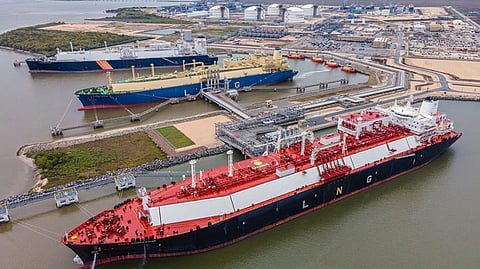Hotter weather, LNG exports lift US natural gas prices
US natural gas futures climbed about two per cent to a one-week high on Friday on near-record flows to liquefied natural gas (LNG) export plants and forecasts for hotter-than-normal weather to continue through the end of August.
To escape that heat, homes and businesses will likely keep their air conditioners cranked up through the end of the month, forcing power generators to burn more gas than usual for this time of year. More than 40 per cent of the electricity produced in the US comes from gas-fired power plants.
The price increase on Friday occurred despite near-record output, ample supplies of gas in storage, and forecasts for less demand next week than previously expected.
Front-month gas futures for September delivery on the New York Mercantile Exchange rose 7.5 cents, or 2.6 per cent, to settle at $2.916 per million British thermal units.
That put the contract down for a fourth week in a row for the first time since late April after losing about three per cent this week, three per cent last week, one per cent two weeks ago, and 13 per cent three weeks ago. The US National Hurricane Center projected Tropical Storm Erin will strengthen into a major hurricane as it moves west across the Atlantic Ocean toward the Bahamas over the next week.
Meteorologists at AccuWeather have said Erin would likely blast Bermuda with wind and rain and produce dangerous beach conditions across the US East Coast next week. Analysts noted the storm, which likely will not make landfall in the US, would also bring cooler weather to the US East Coast.
In addition to Erin, the NHC said a disturbance in the Gulf of Mexico near the Texas-Mexico border had a 50 per cent chance of strengthening into a tropical cyclone over the next seven days.
Even though storms can boost prices by knocking Gulf of Mexico gas production out of service, analysts have said they are more likely to cut demand and prices by shutting LNG export plants and knocking power out to millions of homes and businesses, which reduces the amount of gas electric generators need to burn.
Only about two per cent of all US gas comes from the federal offshore Gulf of Mexico.
Financial group LSEG said average gas output in the Lower 48 states has risen to 108.2 billion cubic feet per day so far in August, up from a record monthly high of 107.9 bcfd in July.
Meteorologists forecast the weather will remain mostly hotter than normal through at least August 30. Despite hotter-than-usual weather so far this summer, record output has allowed energy companies to inject more gas into storage than usual in recent months.
Analysts said gas stockpiles were about six per cent above normal levels for this time of year and will likely keep growing at a faster-than-normal pace in coming weeks.
LSEG projected average gas demand in the Lower 48 states, including exports, would ease from 111.7 bcfd this week to 110.9 bcfd next week and 109.6 bcfd in two weeks. The forecast for next week was lower than LSEG's outlook on Thursday.
The average amount of gas flowing to the eight big US LNG export plants has risen to 16.2 bcfd so far in August, up from 15.5 bcfd in July. That compares with a record monthly high of 16 bcfd in April.
(Reporting by Scott DiSavino in New York; Editing by Paul Simao)


